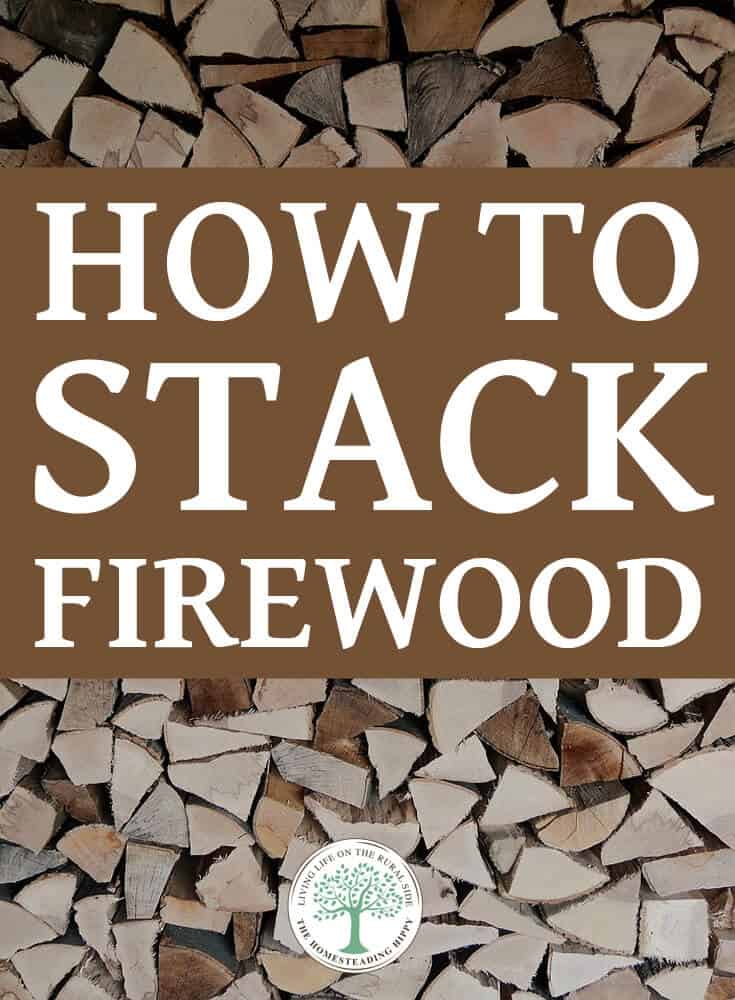Many homesteads use wood heat, ours is no exception. It’s economical, it helps us to deal with trees that have fallen down on our property, and it’s affordable. It also keeps us warm without running up the power bill.
Because we use wood for heat, our homestead has a woodshed. This is where we typically stack all of our firewood for the season.
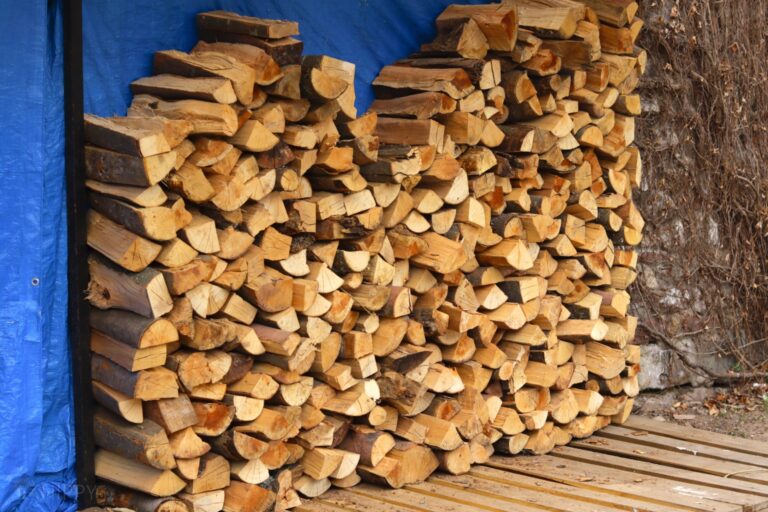
We also have a smaller lean-to on the side of the house where we put a days worth or so of wood so that if we have a sudden snow storm we can just step out the back door and grab an armful of firewood.
If we know that there is a winter storm on the way we will often stack several days worth of firewood here so that we don’t have to shovel our way to the woodshed.
While it’s tempting to put the entire woodpile up against the house, we’re concerned about vermin and bugs infesting our wood supply and then getting into the house. Not a pleasant thought to be sure.
So we’ve avoided stacking any wood within about five feet of our house to make sure that we don’t have to deal with this issue.
Here are some of the more common issues we’ve run across with our firewood supply and how we’ve dealt with it.
Table of Contents
Properly Dried Wood
Properly dried wood requires exposure to the elements to a degree. You want the sun to heat the wood enough to dry it out. You want the wind to help dry it as well.
Our woodshed makes this easy as part of the roof is missing. It was an outbuilding on the property and close to the house so it’s ideal for stacking wood. The rafters are secure and there are only a few missing boards on the roof so we made it work for our woodshed.
We only stack the wood in the section that has covering over the wood. To properly dry firewood for use in your wood stove, you’ll want to stack it properly.
Stacking your wood properly allows the air to freely circulate and thus our wood is always in a stage of drying which is important so that it will properly burn. There are varying opinions on how dry wood should be before it’s burned and this allows us to follow our own style of which wood gets burned when.
Typically it should dry out to only 20 percent moisture content or it should “season for a season” or as some of the old timers say, season it for two seasons or six months.
Some harder woods should season even longer up to one or even two years. Whatever your beliefs are, be sure that you’re careful to stack wood so that it can get some air circulation and dry out so that you’re not burning green wood.
Green wood doesn’t burn as well, requires more kindling, and in many cases can be dangerous.
Covering Wood With A Tarp
As we gather wood and cut wood throughout the year, it is then dumped into a pile near the woodshed that we have and left to season.
We cover it loosely with a tarp if we’re expecting rain or snow before we’ll be able to stack it. Otherwise, the wood will sit there uncovered until we’re able to stack it.
You don’t want to cover a pile of wood on the ground too tightly with a tarp or anything else as the moisture stays in and will keep your wood wet.
As the moisture condenses on the inside of the tarp it will drip down on the wood keeping it wet. So we just put the tarp over it loosely when we absolutely have to due to rain or snow and try to get back to it as soon as possible to stack it.
Keep in mind that a tarp will hold the moisture in and the moisture will cling to the inside of the tarp dripping moisture right back down onto the wood. This will make it take a lot longer for the wood to dry out. Ideally wood that is going to be burned will only have a moisture content of 20 percent or less.
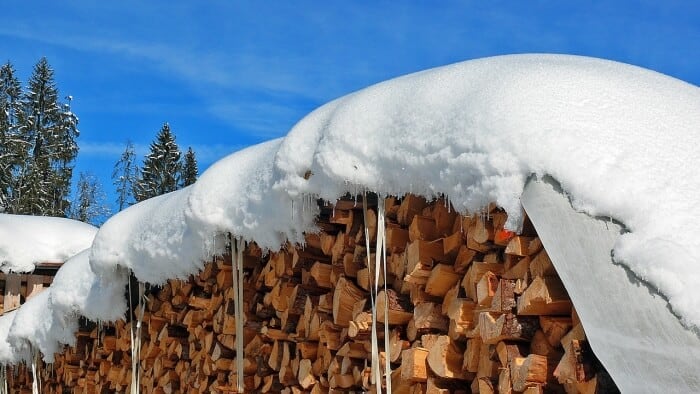
Since the rest of our wood is in a woodshed, we don’t really have to worry about it being covered. It’s in a covered building.
However, our smaller lean to on the side of the house does have a frame and plastic cover over it that is propped up on two long poles to keep the snow from landing on our wood.
It’s not tightly secured and the wood is open on an end of a covered porch so it’s never completely covered where it can retain moisture.
This particular stack of wood is also used up fairly quickly as this is where we stack the wood that will come directly into the house for burning. Typically only a few days worth of wood are stacked here.
Foraged Wood
We often go foraging for wood out in the forest. When we do this we toss it all in the back of a 4 wheeler and only grab pieces that will fit into our wood stove.
Our particular model of wood stove allows us to grab pieces that are just shy of 3 feet in length so we can sometimes find several loads of wood this size that don’t require cutting. It’s a great way to clear our property and to stay warm. Besides, the kids love fine tuning their driving skills in the 4 wheeler.
Sometimes the foraged wood is much larger than the rest of the wood that we have for our wood stove, however, most of it will fit into the wood stove and we really don’t want to work any harder than we have to, so we have come up with a few unique ways to stack larger or longer pieces of wood without having to break it down further or drag out the chain saw.
- Stand it upright in a large garbage can (we have a small collection of old rubberized garbage cans that have holes in them from over use. These are ideal for placing longer pieces or placing branches that have been trimmed from trees upright for storage.
- Lay it out on pallets to denote where green wood and dry wood change.
- Place it in gray landscaping bricks that have the two holes in them upright and use it to support wood by creating a lean to with it. Set more bricks in between and then stack the regular sized firewood on the regular sized bricks allowing the taller “poles” to support the ends.
Sort Your Wood
The rest of our wood comes from felled trees on the property or the neighbors property. We often get trees cut down to a plateau with the tractor and will go up to the plateau and saw it all up then roll the resulting logs down the hill to the house where it will be split or stacked as is depending on the diameter of the wood.
Of course, once it’s rolled down the hill, we have to stack it in the woodshed. To do this, we have a sorting system. Greener or wetter wood goes in the very back of the woodshed. We have scavenged some old pallets from around the community and use these as our platform for stacking the wood.
The greener the wood, the closer to the back it goes. That way, by the time we get to it, it is typically seasoned to just the right dryness for our wood stove. We like to leave plenty of space between the logs to ensure that they have some air flow and room to dry out.
To do this we work it rather like a jig saw puzzle. We place the larger pieces on the flat pallets and build a row or two on that level. Then, we take medium sized pieces and fill in between those pieces so that air flow can still get around the various pieces of wood to allow them to dry out.
The Middle Section
With the greener wetter wood to the far back and left of our woodshed and the drier wood to the far right, the middle section is sorted according to how dry it is.
The drier wood is placed closer to the drier or the right side while the wetter woods are stacked closer to the green or wet side of the woodshed.
We try to bring in the dry wood and kindling and slowly work down toward where we have the wetter or greener wood.
Occasionally we’ll get a piece of green wood by accident, but for the most part this works very well and everyone on our homestead understands how it works so from the youngest to the oldest we all stack the wood in this fashion.
That’s one thing about a homestead, everyone helps. Everyone has a job to do from the youngest to the oldest. We even have one dog that brings us kindling to the back door when he sees that we’re bringing it in.
Puzzle Style
As we stack we sort out the smaller pieces and set them in another pile so we can use them to fill in or to put on the top rows as we complete stacking our wood.
With every stack of wood that comes to the main house from the plateau, there is an area that it’s dumped that denotes how dry it is. The driest woods get dumped closest to the woodshed and will go into the front area.
One of grandpas must’s for stacking wood was that he tried to stack the wood so that the ends were all about the same position in the stack. He told us it would help the wood stack to stay put.
If you have a few odd pieces set them aside so that you can keep similar sized pieces of wood together. This may mean you have a smaller stack somewhere else in the woodshed, but it works well to try to make sure your stacks of wood are as stable as possible.
Our woodshed is fairly square in shape so it’s easy to stack on only one side and still get into and out of the woodshed. We have about four rows of wood stacked on the ground level and then we begin working our way up.
Some years we have more wood than others but the average is about 5 feet or 6 feet tall. Typically this is about 9 cords of wood. We heat our entire house with wood so the more the better, what isn’t used can be used the following year.
Drier Wood And Kindling
The drier woods and the kindling are all stored near the front of our woodshed where they can be easily accessed to start a fire in the wood stove. We sort these accordingly.
The kindling is on the far right as you turn into the woodshed and it’s at the very front. The larger pieces are stacked just to the left of the kindling and used up a few at a time.
We work our way down when we bring wood in by stocking up the kindling into a rubberized container near the inside of the back laundry room area and then we stack the other wood nearer to the wood stove. That way small sparks won’t suddenly catch all of the kindling on fire and create a disaster.
Criss-Crossed Ends
One trick for stacking firewood that my grandfather taught us was to criss-cross the ends of the stacks. That is we stack 3 pieces in one direction with a few inches between them, and then we stack 3 more pieces the opposite direction with a few inches between them.
This helps the air to circulate through the stack of wood more readily according to grandpa. It also gives the ends a bit more stability so that you won’t have a leaning stack of wood that can easily fall over.
Since I never argued with grandpa I still do this today and my wood seems to be dry and ready come fall.
Rounds Vs. Split Wood
Sometimes we’re in a crunch for time and we don’t have time to split all of the wood. When this happens we may stack some of the rounds in a separate section of our woodshed.
We’ll grab these out a few at a time and split them and then add them to the dwindling stack of firewood as we take from it.
Smaller rounds that are dried out may simply be placed on the fire as an “overnight” log. That way we don’t have to get up in the middle of the night as often to restock the wood stove. As long as the smaller rounds aren’t too terribly large this works well.
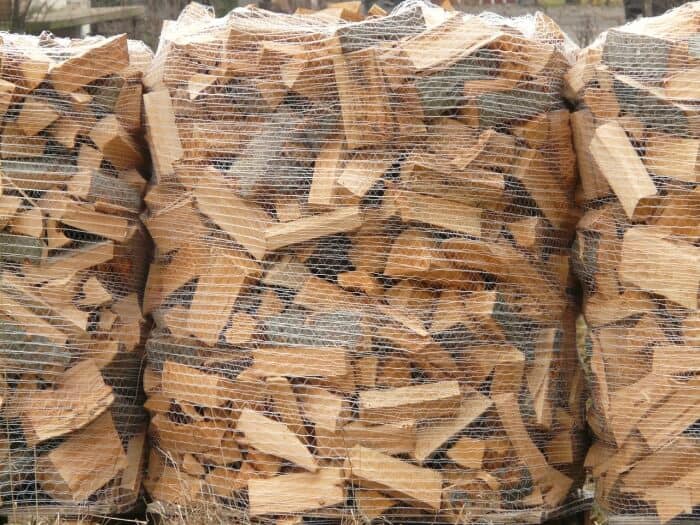
Firewood Stacking Tricks
Don’t work harder than you have to. These tricks have helped us to maximize space, have drier wood and to speed up the process of stacking the firewood.
One of our sons is really good at organizing the woodshed and he directs the others. If you have a “take charge” person who is good at it, let them do that part. It really speeds things up and helps to keep the momentum going for everyone else.
Bark Side Up
We stack our firewood bark side up so that the piece of wood won’t form a bowl and hold onto the water or moisture. As the bark slips off of the pieces of wood we have an old rubberized trash can that we toss it into and when we’re low on kindling it works great.
One of the younger kids is in charge of taking the bark from a pile where the others put it and placing it into a container for kindling.
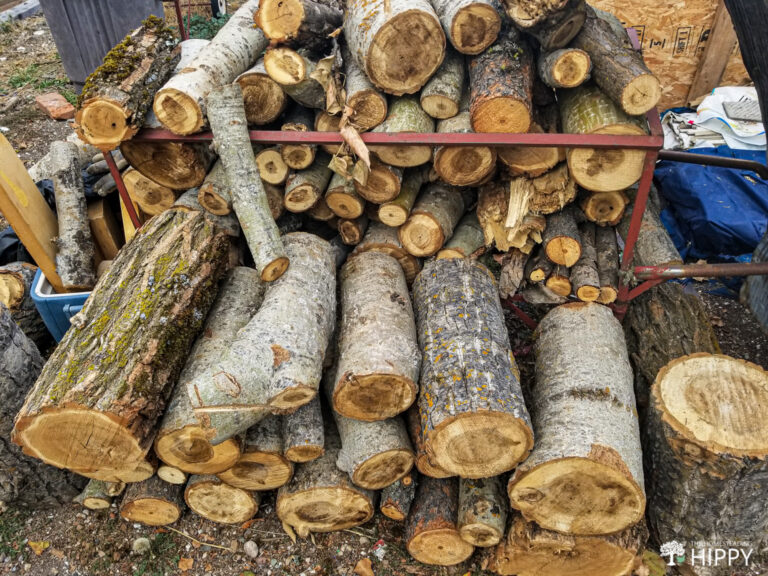
Wet Or Green Wood
Wet or green wood will burn however, it creates more creosote that coats the chimney and this creosote can start a fire in the chimney.
You’re also going to have to burn more wood to stay warm if you use wet wood so it’s far more economical and efficient to burn seasoned dry wood.
Split Wood Vs Rounds
We’ve found that splitting our wood does make it dry out faster. There is less surface area and there is no bark to hold in the moisture on one side of the piece that is split.
If you find a piece that is too stubborn to split, set it aside in a greener wood section and try again in a few months.
Dry Wood
Dry wood is lighter in weight, and its bark will slip off more readily. We also think that dried wood is easier to split but others differ in their opinion on this. Harder woods, like oak or cherry for example, may take up to 2 years to dry.
The longer stacked firewood sits in the stack, the quicker it will dry. It’s important to note here that just because a tree has fallen and been lying in the woods for a long period of time, doesn’t necessarily mean that it’s completely dry. If it’s not being rotated only one section may be dry.
Rotten Wood
We’ve had some rotten wood and it does burn. In many cases, it’s so disintegrated that it’s not really worth our time. It will burn, but it’s not as efficient. If we’re at the end of the wood stack and it’s near the end of the season, we will use it if we have to.
Plan Ahead
Move last years green wood to the front of the woodshed if you still have any left. That way you can start out with the driest wood when you begin your new year burning wood in the fall.
We try to plan ahead each year for our firewood supply. Obviously some winters are harsher than others and we’re going to require more firewood.
Since we never know for sure, we take all the wood that is offered to us by offering to clear the scrap wood from various projects for an elderly neighbor that is grateful for our help.
We also scavenge some of our wood on our property (trees or branches that have fallen) and it helps to keep our property neat and tidy and it gives us more firewood.
We tie ribbons around trees that we’ll come back for and cut down for firewood. These particular trees may be choking out other trees, damaged from winds, dead, or some other issue.
Our elderly neighbor has asked us if we would mind doing this for him as well. This gives us plenty of firewood to stack.
Stacking firewood on our homestead is a family event. From the youth of 10 and up everyone helps in some fashion.
The younger family members are given light duty tasks such as putting kindling into bundles or running for soda’s while everyone else is stacking the larger items.
If you can stack firewood as it comes in, it’s far better. You’ll get the task done more quickly in the long run and you won’t have to spend several days stacking wood or give up an entire weekend.
Some years we seem to be stacking wood for weeks on end because we wait until the last minute to stack it.
Safety Measures
Always wear gloves when stacking firewood. Gloves help to prevent splinters and they also prevent you from getting tree sap on your hands which is challenging to get off of your hands.
Wear long-sleeved clothing when stacking firewood, even if it’s hot out. Scrapes and scratches hurt and you don’t want to have to stop for an injury.
Wear closed toed shoes, if you have steel toed boots, all the better. When a piece of firewood falls on your foot, you’ll understand why.
If you’re the person with the chainsaw or splitting wood with an ax or maul, wear goggles to protect your eyes from flying splinters of wood.
